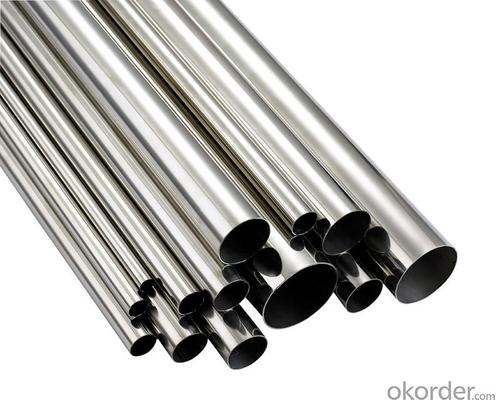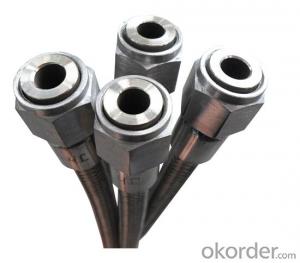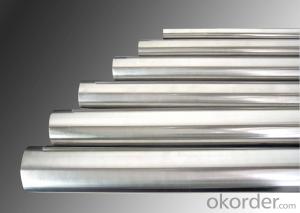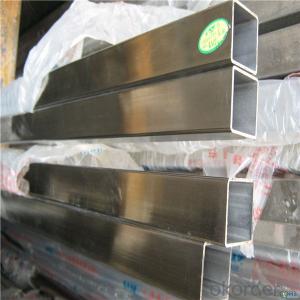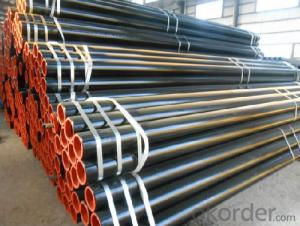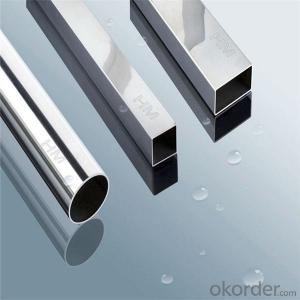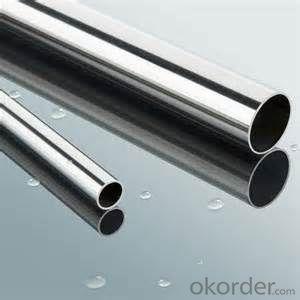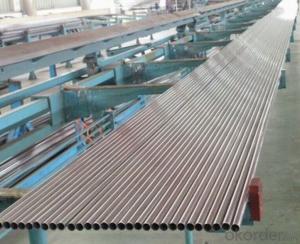STAINLESS STEEL PIPES 201 & 410 pipes
- Loading Port:
- China Main Port
- Payment Terms:
- TT OR LC
- Min Order Qty:
- -
- Supply Capability:
- -
OKorder Service Pledge
OKorder Financial Service
You Might Also Like
Description:
Stainless Steel Pipe
Material:
304 321 316 310
Packing:
In bundle
MOQ:
5 TONS
Comparison of standardized steels
| EN-standard Steel no. k.h.s DIN | EN-standard Steel name | SAE grade | UNS |
|---|---|---|---|
| 1.4109 | X65CrMo14 | 440A | S44002 |
| 1.4112 | X90CrMoV18 | 440B | S44003 |
| 1.4125 | X105CrMo17 | 440C | S44004 |
| | | 440F | S44020 |
| 1.4016 | X6Cr17 | 430 | S43000 |
| 1.4408 | G-X 6 CrNiMo 18-10 | 316 | |
| 1.4512 | X6CrTi12 | 409 | S40900 |
| | | 410 | S41000 |
| 1.4310 | X10CrNi18-8 | 301 | S30100 |
| 1.4318 | X2CrNiN18-7 | 301LN | |
| 1.4307 | X2CrNi18-9 | 304L | S30403 |
| 1.4306 | X2CrNi19-11 | 304L | S30403 |
| 1.4311 | X2CrNiN18-10 | 304LN | S30453 |
| 1.4301 | X5CrNi18-10 | 304 | S30400 |
| 1.4948 | X6CrNi18-11 | 304H | S30409 |
| 1.4303 | X5CrNi18-12 | 305 | S30500 |
| | X5CrNi30-9 | 312 | |
| 1.4541 | X6CrNiTi18-10 | 321 | S32100 |
| 1.4878 | X12CrNiTi18-9 | 321H | S32109 |
| 1.4404 | X2CrNiMo17-12-2 | 316L | S31603 |
| 1.4401 | X5CrNiMo17-12-2 | 316 | S31600 |
| 1.4406 | X2CrNiMoN17-12-2 | 316LN | S31653 |
| 1.4432 | X2CrNiMo17-12-3 | 316L | S31603 |
| 1.4435 | X2CrNiMo18-14-3 | 316L | S31603 |
| 1.4436 | X3CrNiMo17-13-3 | 316 | S31600 |
| 1.4571 | X6CrNiMoTi17-12-2 | 316Ti | S31635 |
| 1.4429 | X2CrNiMoN17-13-3 | 316LN | S31653 |
| 1.4438 | X2CrNiMo18-15-4 | 317L | S31703 |
| 1.4362 | X2CrNi23-4 | 2304 | S32304 |
| 1.4462 | X2CrNiMoN22-5-3 | 2205 | S31803/S32205 |
| 1.4539 | X1NiCrMoCu25-20-5 | 904L | N08904 |
| 1.4529 | X1NiCrMoCuN25-20-7 | | N08926 |
| 1.4547 | X1CrNiMoCuN20-18-7 | 254SMO | S31254 |
Stainless steel’s resistance to corrosion and staining, low maintenance and familiar lustre make it an ideal material for many applications. There are over 150 grades of stainless steel, of which fifteen are most commonly used. The alloy is milled into coils, sheets, plates, bars, wire, and tubing to be used in cookware, cutlery, household hardware, surgical instruments, major appliances, industrial equipment (for example, in sugar refineries) and as an automotive and aerospace structural alloy and construction material in large buildings. Storage tanks and tankers used to transport orange juice and other food are often made of stainless steel, because of its corrosion resistance. This also influences its use in commercial kitchens and food processing plants, as it can be steam-cleaned and sterilized and does not need paint or other surface finishes.
Stainless steel is used for jewelry and watches with 316L being the type commonly used for such applications. It can be re-finished by any jeweler and will not oxidize or turn black.
Some firearms incorporate stainless steel components as an alternative to blued or parkerized steel. Some handgun models, such as the Smith & Wesson Model 60 and the Colt M1911 pistol, can be made entirely from stainless steel. This gives a high-luster finish similar in appearance to nickel plating. Unlike plating, the finish is not subject to flaking, peeling, wear-off from rubbing (as when repeatedly removed from a holster), or rust when scratched.
Architecture[edit]
Stainless steel is used for buildings for both practical and aesthetic reasons. Stainless steel was in vogue during the art deco period. The most famous example of this is the upper portion of the Chrysler Building (pictured). Some diners and fast-food restaurants use large ornamental panels and stainless fixtures and furniture. Because of the durability of the material, many of these buildings retain their original appearance.
Type 316 stainless is used on the exterior of both the Petronas Twin Towers and the Jin Mao Building, two of the world's tallest skyscrapers.[17]
The Parliament House of Australia in Canberra has a stainless steel flagpole weighing over 220 tonnes (240 short tons).
The aeration building in the Edmonton Composting Facility, the size of 14 hockey rinks, is the largest stainless steel building in North America.
Bridges[edit]
Cala Galdana Bridge in Minorca (Spain) was the first stainless steel road bridge.
Sant Fruitos Pedestrian Bridge (Catalonia, Spain), arch pedestrian bridge.
Padre Arrupe Bridge (Bilbao, Spain) links the Guggenheim museum to the University of Deusto.[18]
Monuments and sculptures[edit]
The Unisphere, constructed as the theme symbol of the 1964-5 World's Fair in New York City, is constructed of Type 304L stainless steel as a sphere with a diameter of 120 feet, or 36.57 meters.
The Gateway Arch (pictured) is clad entirely in stainless steel: 886 tons (804 metric tonnes) of 0.25 in (6.4 mm) plate, #3 finish, type 304 stainless steel.[19]
The United States Air Force Memorial has an austenitic stainless steel structural skin.
The Atomium in Brussels, Belgium was renovated with stainless-steel cladding in a renovation completed in 2006; previously the spheres and tubes of the structure were clad in aluminium.
The Cloud Gate sculpture by Anish Kapoor, in Chicago US.
The Sibelius monument in Helsinki, Finland, is made entirely of stainless steel tubes.
The Man of Steel (sculpture) under construction in Rotherham, England.
Other[edit]
- Automotive bodies
The Allegheny Ludlum Corporation worked with Ford on various concept cars with stainless steel bodies from the 1930s through the 1970s, as demonstrations of the material's potential. The 1957 and 1958 Cadillac Eldorado Brougham had a stainless steel roof. In 1981 and 1982, the DeLorean DMC-12 production automobile used stainless steel body panels over a glass-reinforced plasticmonocoque. Intercity buses made by Motor Coach Industries are partially made of stainless steel. The aft body panel of the Porsche Cayman model (2-door coupe hatchback) is made of stainless steel. It was discovered during early body prototyping that conventional steel could not be formed without cracking (due to the many curves and angles in that automobile). Thus, Porsche was forced to use stainless steel on the Cayman.
- Passenger rail cars
Rail cars have commonly been manufactured using corrugated stainless steel panels (for additional structural strength). This was particularly popular during the 1960s and 1970s, but has since declined. One notable example was the early Pioneer Zephyr. Notable former manufacturers of stainless steel rolling stock included the Budd Company (USA), which has been licensed to Japan's Tokyu Car Corporation, and the Portuguese company Sorefame. Many railcars in the United States are still manufactured with stainless steel, unlike other countries who have shifted away.
- Aircraft
Budd also built an airplane, the Budd BB-1 Pioneer, of stainless steel tube and sheet, which is on display at the Franklin Institute.
The American Fleetwings Sea Birdamphibious aircraft of 1936 was also built using a spot-welded stainless steel hull.
The Bristol Aeroplane Company built the all-stainless steel Bristol 188 high-speed research aircraft, which first flew in 1963.
The use of stainless steel in mainstream aircraft is hindered by its excessive weight compared to other materials, such as aluminum.
- Jewelry
Valadium, a stainless steel and 12% nickel alloy is used to make class and military rings. Valadium is usually silver-toned, but can be electro-charged to give it a gold tone. The gold tone variety is known as Sun-lite Valadium
- Q: Are stainless steel pipes suitable for air conditioning systems?
- Stainless steel pipes are indeed appropriate for air conditioning systems. Given their exceptional resistance to corrosion, stainless steel emerges as a flawless material for air conditioning systems, especially in environments where moisture and condensation are prevalent. Moreover, its robustness, durability, and ability to endure high temperatures render it a perfect match for the demanding conditions commonly encountered in air conditioning systems. Furthermore, the smooth inner surface of stainless steel pipes aids in reducing friction and enhancing the airflow. All in all, stainless steel pipes offer top-notch performance and reliability when utilized in air conditioning systems.
- Q: How do you prevent leakage in stainless steel pipes?
- To prevent leakage in stainless steel pipes, there are various steps that can be taken: 1. Installation should be done by trained professionals with expertise in working with stainless steel. This involves using suitable fittings, connectors, and seals to establish a tight and secure connection. 2. Regular inspections should be conducted to detect any signs of leakage, such as corrosion, cracks, or loose fittings. This allows for proactive maintenance and repairs before a significant leak occurs. 3. Opt for high-quality materials that meet industry standards when selecting stainless steel pipes. Inferior materials or substandard manufacturing can result in weak points and an increased risk of leakage. 4. Ensure proper sealing by using effective methods like gaskets, o-rings, or thread sealants to create a tight seal between pipe joints. This prevents any potential points of leakage. 5. Before putting the stainless steel pipes into operation, conduct pressure tests to ensure their integrity. This helps identify any weaknesses or leaks that may have occurred during installation. 6. Implement a regular maintenance schedule to inspect and maintain the stainless steel pipes. This includes checking for corrosion, replacing worn-out seals or gaskets, and tightening fittings as needed. 7. Avoid over-tightening fittings, as it can cause stress and damage to the pipe, leading to leaks. Follow the manufacturer's guidelines for proper tightening torque. 8. Properly support and secure stainless steel pipes to prevent stress or movement that can result in leaks. This involves using suitable hangers, clamps, or brackets designed for stainless steel pipes. By following these preventive measures, the likelihood of leakage in stainless steel pipes can be significantly reduced, ensuring the long-term integrity and reliability of the piping system.
- Q: SA-179 what kind of material is steel pipe?
- Seamless steel pipe having a hollow cross section, used as a conduit for conveying fluids, such as pipelines for transporting petroleum, natural gas, gas, water, and certain solid materials.
- Q: How are stainless steel pipes joined together?
- Stainless steel pipes are typically joined together using a variety of methods depending on the specific application and requirements. The most common methods for joining stainless steel pipes include welding, threaded connections, and flanges. Welding is the most durable and secure method of joining stainless steel pipes. It involves melting the edges of the pipes together and fusing them using heat. There are different types of welding techniques used, such as TIG (Tungsten Inert Gas) welding, MIG (Metal Inert Gas) welding, and stick welding. TIG welding is often preferred for stainless steel due to its precise control and clean finish. Threaded connections are another popular method for joining stainless steel pipes, especially for smaller diameters. This method involves screwing the pipes together using threads on the outer surface of the pipe ends. Threaded connections provide a strong and reliable joint, but they may not be suitable for applications with high pressure or temperature. Flanges are used to join stainless steel pipes when a detachable connection is required. A flange is a flat, circular plate with bolt holes that allows two pipes to be bolted together. Flanges are commonly used in industries where frequent assembly and disassembly are necessary or where maintenance and repair are required. It is important to note that the choice of joining method depends on factors such as the pipe diameter, pressure rating, temperature, and specific application requirements. Additionally, proper preparation and alignment of the pipes, along with the use of suitable filler materials and techniques, are crucial for achieving strong and leak-free joints in stainless steel pipe systems.
- Q: How do stainless steel pipes compare to carbon steel pipes?
- Stainless steel pipes and carbon steel pipes are both widely used in various industries and applications, but they differ in terms of their composition, strength, durability, and corrosion resistance. One of the key differences between stainless steel pipes and carbon steel pipes lies in their composition. Stainless steel pipes are made from an alloy of iron with a minimum of 10.5% chromium content, which provides excellent corrosion resistance. On the other hand, carbon steel pipes are primarily made from iron and carbon, with lower amounts of other elements. In terms of strength, carbon steel pipes are generally stronger and more rigid than stainless steel pipes. This characteristic makes carbon steel pipes suitable for applications that require high pressure or heavy load-bearing capacity. Stainless steel pipes, although not as strong as carbon steel pipes, still possess good strength and are suitable for various applications where corrosion resistance is a priority. When it comes to corrosion resistance, stainless steel pipes outperform carbon steel pipes. The chromium content in stainless steel forms a protective layer on the surface, known as the passive film, which prevents corrosion and rusting. This makes stainless steel pipes ideal for applications in corrosive environments, such as chemical processing, marine, and offshore industries. Carbon steel pipes, on the other hand, are more prone to corrosion and require additional protective coatings or treatments to enhance their resistance to corrosion. Durability is another important factor to consider when comparing stainless steel pipes to carbon steel pipes. Stainless steel pipes are known for their long lifespan and resistance to wear and tear, making them a cost-effective choice in the long run. Carbon steel pipes, while durable, may require more maintenance and regular inspections to prevent corrosion and degradation. In conclusion, stainless steel pipes offer superior corrosion resistance, making them more suitable for applications in corrosive environments. Carbon steel pipes, on the other hand, are stronger and more rigid, making them suitable for high-pressure applications. The choice between stainless steel and carbon steel pipes ultimately depends on the specific requirements of the application, including the level of corrosion resistance, strength, and durability needed.
- Q: Is stainless steel flexible enough for plumbing applications?
- Yes, stainless steel is flexible enough for plumbing applications. It can be easily bent and shaped to fit the required plumbing configurations, making it a versatile and commonly used material in the plumbing industry.
- Q: Can stainless steel pipes be used for steam applications?
- Yes, stainless steel pipes can be used for steam applications. Stainless steel is highly resistant to corrosion and can withstand high temperatures, making it a suitable choice for carrying steam. Additionally, stainless steel pipes have excellent strength and durability, ensuring a reliable and long-lasting performance in steam applications.
- Q: How do you prevent stainless steel pipes from corroding?
- To prevent stainless steel pipes from corroding, it is important to ensure regular cleaning and maintenance. This involves removing any dirt or debris from the surface of the pipes and using appropriate cleaning agents. Additionally, it is important to avoid exposure to harsh chemicals or corrosive substances. Applying a protective coating or using corrosion-resistant materials for fittings and joints can also help minimize the risk of corrosion. Regular inspection and prompt repair of any damage or signs of corrosion are crucial to maintaining the longevity of stainless steel pipes.
- Q: Are stainless steel pipes suitable for power plants?
- Yes, stainless steel pipes are highly suitable for power plants. They offer exceptional resistance to corrosion, high temperatures, and pressure, making them ideal for transporting various fluids and gases within power plants. Additionally, stainless steel pipes have excellent strength and durability, ensuring long-term reliability in the demanding operating conditions of power plants.
- Q: Are stainless steel pipes suitable for wastewater pumping stations?
- Stainless steel pipes prove to be a suitable option for wastewater pumping stations. Their exceptional corrosion resistance makes them ideal for environments abundant in moisture and chemicals, like wastewater pumping stations. These pipes are impervious to rust and can withstand the corrosive properties of wastewater, which often contains a variety of chemicals and contaminants. Furthermore, stainless steel pipes possess remarkable strength and durability, allowing them to handle the pressure and flow demands of wastewater pumping systems. Additionally, they have a smooth interior surface that minimizes friction, thereby enhancing water flow efficiency. In conclusion, stainless steel pipes are an outstanding selection for wastewater pumping stations, thanks to their corrosion resistance, strength, and durability.
Send your message to us
STAINLESS STEEL PIPES 201 & 410 pipes
- Loading Port:
- China Main Port
- Payment Terms:
- TT OR LC
- Min Order Qty:
- -
- Supply Capability:
- -
OKorder Service Pledge
OKorder Financial Service
Similar products
Hot products
Hot Searches
Related keywords

